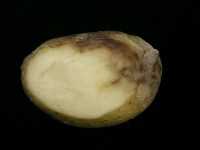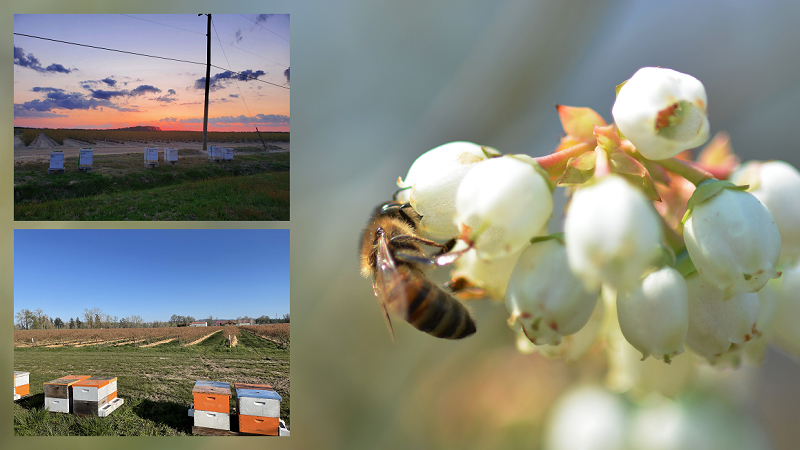Late Blight Pointers For Potatoes

Late blight is a disease potato growers love to hate, and depending on the weather, they may or may not get their fill this season. It is important to be on high alert if temperatures dip or if rain is in the forecast as late blight thrives in cool, wet weather. As Mother Nature is predictably unpredictable, growers need to be on the defense at all times.
The potato protection process, however, begins by choosing seed that is disease free and ends with ensuring proper care in storage. Steven B. Johnson, a crops specialist and Extension professor at the University of Maine’s Cooperative Extension, offered 10 pointers on what actions need to be taken to safeguard potatoes from a late blight invasion.
1. Know your source of seed and the history of the seed. Prior to planting, Johnson says to make sure the seed is examined for flaws and only plant tubers without blemishes.
2. Treat seeds for late blight control. He recommends not precutting, if there is any risk, because growers can encounter tuber-to-tuber spread of late blight.
3. Early detection is critical. “That is worth more than all the curative things you can throw at late blight,” states Johnson. He encourages growers to walk fields and look for known places they have seen late blight before or would expect to find it, such as low lying areas, foggy areas, or places in the field where fungicide coverage is not as good. “It might be shaded areas, too. You need to be out there physically looking – and not from a tractor seat.”
4. Educate workers on what to look for in the field. Everyone working in the field needs to know the early symptoms of late blight, which include water-soaked lesions, he says. “Everyone needs to be able to recognize when something is not right and tell someone about it. If it is found early, it can be controlled.” Not cured, but controlled, he adds.
5. Be wary of cull piles. The pile doesn’t necessarily have to be a dump pile from potato storage, explains Johnson. “It can be a seed chip pile that got cleaned out of a seed cutter and pushed to the side that is ready to go, and [those seeds] have late blight.”
Occasionally there are volunteer issues in the field that may present a problem, too, he adds.
6. Pay close attention to leaves as the season progresses. When the plants come up, they are rapidly doubling their leaf area every four to five days, and if there is a late blight threat or presence of late blight at that time, it is a very difficult to keep it out because the foliage is expanding so rapidly, states Johnson.
At this point, it is important to be diligent looking for late blight. “If late blight gets a foothold at this early point of the season, control can be nearly impossible,” he stresses. “Early detection is paramount and it occurs from early observations.”
7. Choosing to kill a portion of the field to save the bulk of the crop. “There are times when crop destruction or killing an area or a portion of the field has a lot of merit, and sometimes it is past making a difference,” he says. “If there is a concentrated spot of late blight that has not really started to spread outward from the area, it is good time to kill the spot. This technique is most valuable early in the season.”
8. An ounce of prevention. With a disease like late blight — that can’t be cured — it is important to try to prevent it from destroying the crop with preventive fungicide applications. “Late blight is not a disease we can chase,” he explains. “If it gets ahead of you, you have to wait for the weather to slow it down because we have nothing that will really do that and by that time, devastation can be rampant.”
9. Tuber protection. Toward the end of the season, growers are looking at tuber protection and there is a relationship between stem infections and tuber infections, says Johnson. At that point the choice of protective material can change for tuber control, which may include vine killing early.
For example, says Johnson, if rain is coming and it is a week from harvest, it’s a good idea to kill the vines before the rain comes. The result is – in the case of heavily infected fields — you won’t have the inoculum coming into the tubers.
“You are going to get less yield but at that point you are making a decision based on a cost benefit that you will to sacrifice some yield for a week to save the crop versus hanging on and the whole thing bottoms out,” he states.
10. Diligent storage management. Johnson encourages growers to address the conditions as they are going into the storage season. For example, are you harvesting wet are or are you harvesting dry? Is it cold? Is it warm? The conditions present as potatoes are being placed in storage will impact the cool down of the crop, which in turn, impacts disease in storage.
Johnson says in Maine, potatoes can be stored into September, so any rot is not acceptable and there is zero tolerance for late blight.










